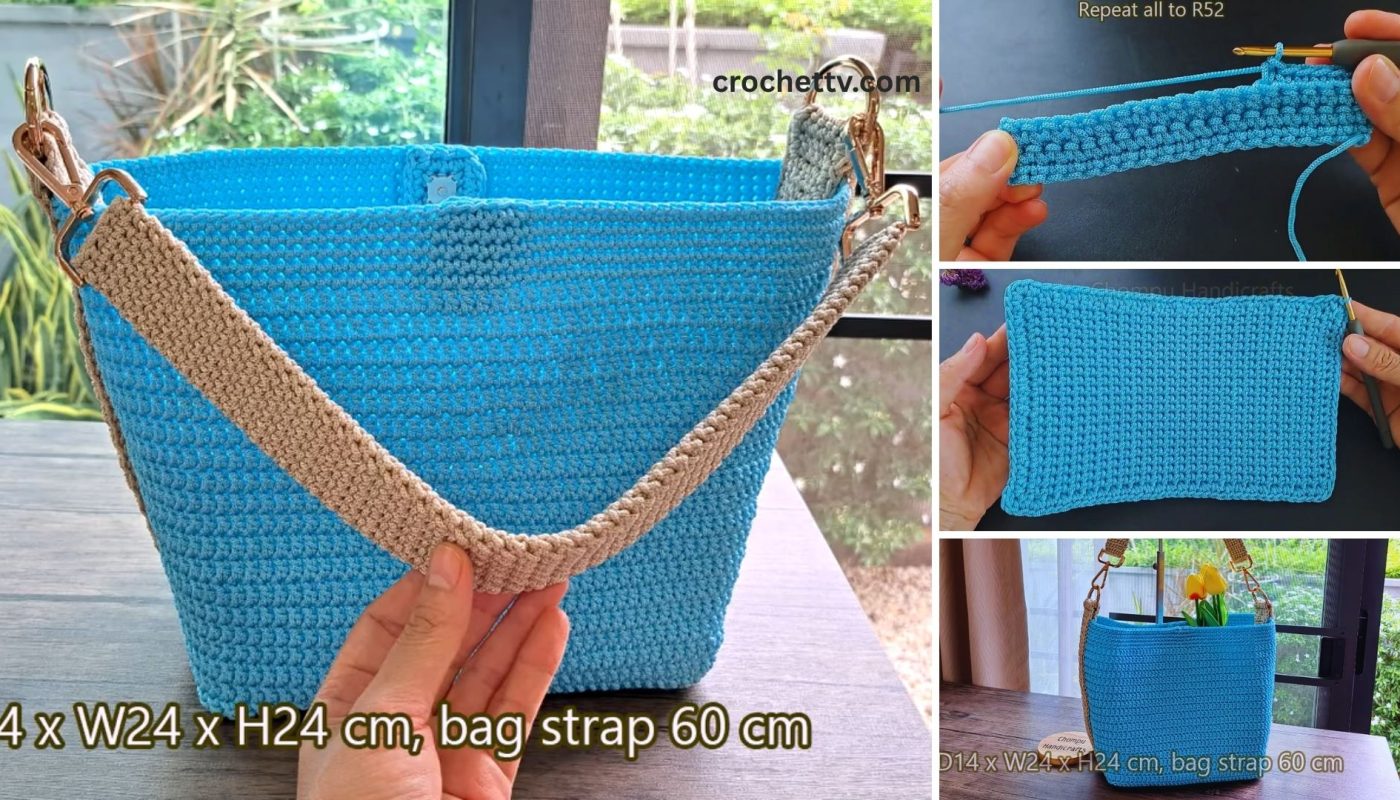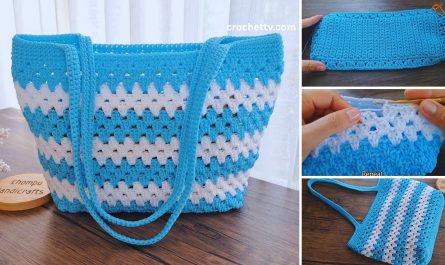Let’s create your very own DIY crochet tote bag! This project is an excellent choice for beginners and experienced crocheters alike. You’ll end up with a versatile, sturdy, and eco-friendly bag perfect for groceries, books, beach essentials, or just as a stylish everyday carry-all.
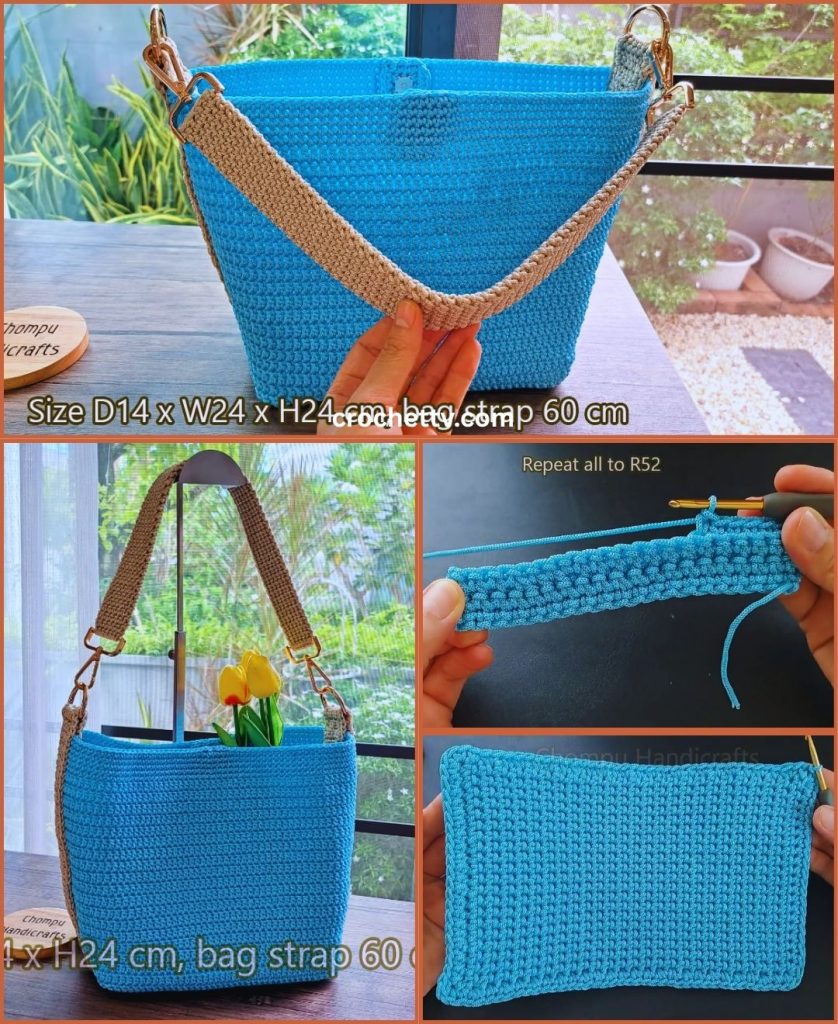
How to DIY Crochet Tote Bag: Step-by-Step Tutorial
This detailed guide will walk you through each stage of crocheting a practical and durable tote bag: building a solid base, working up the sides, and adding comfortable handles.
Skill Level: Beginner
This project is perfect if you’re comfortable with (or ready to learn!):
- Chain (ch): The most fundamental crochet stitch.
- Slip Stitch (sl st): For joining rounds.
- Single Crochet (sc): A dense, sturdy stitch.
- Half Double Crochet (hdc): A slightly taller stitch that works up faster.
- Working in rounds: Crocheting in a circular fashion.
- Fastening off: Securing your yarn.
- Weaving in ends: The essential finishing touch.
Finished Tote Bag Dimensions (Approximate):
Using worsted weight cotton yarn and the suggested hook, your finished tote bag will typically measure around:
- Base: 10 inches (25 cm) wide by 3 inches (7.5 cm) deep oval
- Height: 10-12 inches (25-30 cm) (excluding handles)
- Handles: 8-10 inches (20-25 cm) tall loop
You can easily adjust the size of your bag by changing the starting chain length for the base or the number of rounds for the body.
Materials You’ll Need:
Gathering your materials beforehand ensures a smooth and enjoyable crocheting session.
- Yarn: Approximately 400-500 yards (365-457 meters) of Worsted Weight (Medium #4) Cotton or Cotton Blend Yarn.
- Why Cotton? Cotton yarn is highly recommended for bags because it’s durable, holds its shape well, and creates a sturdy fabric that resists stretching, especially when you fill your bag. Choose any color you love!
- Crochet Hook: Size H/5.0mm. This hook size works well with worsted weight cotton yarn, helping you create a firm, dense fabric that will allow your tote bag to stand up nicely on its own.
- Yarn Needle (Tapestry Needle): Essential for seamlessly weaving in all your loose yarn tails at the end of the project. It has a blunt tip and a large eye.
- Scissors: Any sharp pair of scissors.
- Stitch Marker (Optional but Recommended): Incredibly helpful for marking the first stitch in each round, especially when working the base in a continuous spiral.
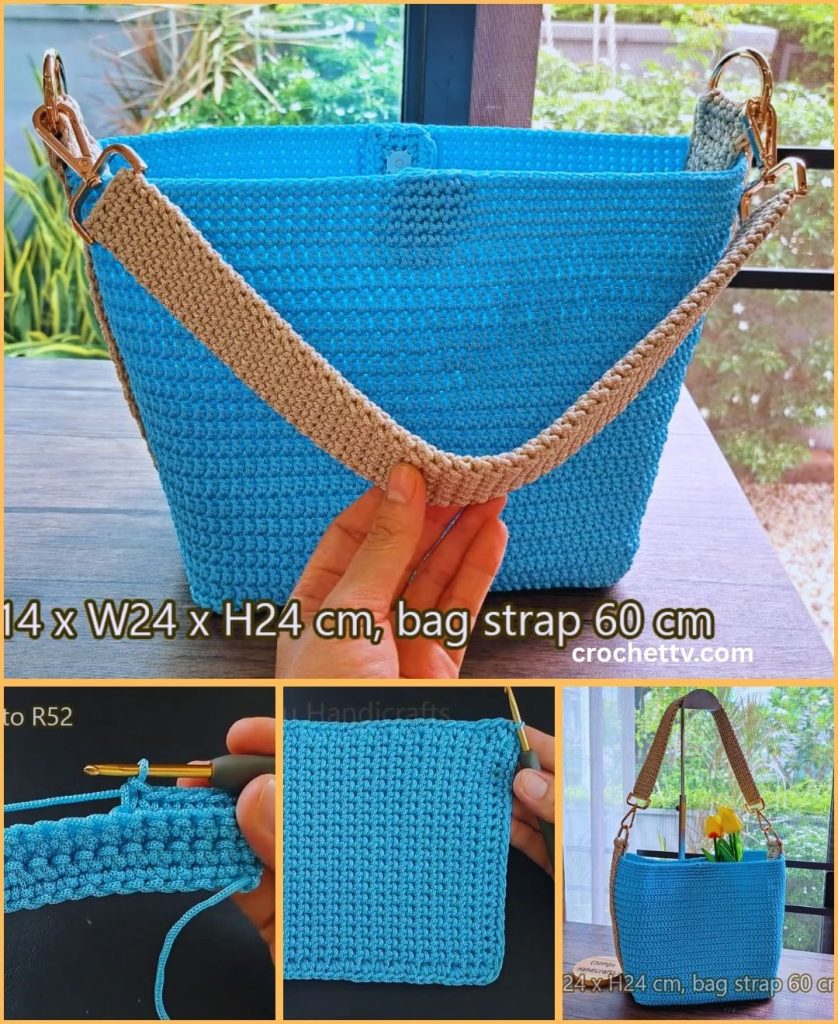
Let’s DIY Your Crochet Tote Bag!
We’ll build this bag from the bottom up: starting with a strong oval base, then working the body of the bag upwards, and finally adding simple, integrated handles.
Part 1: The Oval Base
You’ll begin by creating a flat, sturdy oval shape that forms the bottom of your tote bag. This is achieved by working single crochet stitches around a starting chain.
- Starting Chain:
- Make a slip knot with your yarn and place it onto your H/5.0mm crochet hook.
- Chain (ch) 21. (This chain length determines the initial width of your bag. If you want a wider or narrower bag, adjust this chain. It’s best if it’s an odd number for this pattern.)
- Round 1 (Working around the chain):
- Work 2 single crochet (sc) stitches into the 2nd chain from your hook.
- (Optional: Place your stitch marker in the first sc you just made. This will be the first stitch of your round for tracking.)
- Work 1 sc into each of the next 18 chains.
- In the last chain (the 21st chain from your hook): Work 4 sc into this single chain. This creates a neat turn around the end of your chain.
- Now, work back down the other side of your starting chain, crocheting into the bottom loops (the unworked loops) of each chain.
- Work 1 sc into each of the next 18 stitches.
- In the last stitch (this will be the same chain where you placed your very first 2 sc): Work 2 sc into this chain. This finishes turning the other corner.
- You should now have a total of 44 sc stitches (2 + 18 + 4 + 18 + 2 = 44). Do NOT join with a slip stitch yet. For the base, you’ll work in continuous rounds (spirals) to avoid a visible seam.
- Round 2 (Continuing the Oval Shape):
- Work 2 sc into the first stitch of the round (this is the stitch marked by your stitch marker).
- (If using, move your stitch marker to this new first sc of the round.)
- Work 1 sc into the next stitch.
- Work 1 sc into each of the next 18 stitches.
- Work 2 sc into each of the next 3 stitches.
- Work 1 sc into each of the next 18 stitches.
- Work 2 sc into each of the next 2 stitches.
- You should now have 50 sc stitches. Continue working in continuous rounds.
- Round 3 (Final Base Round):
- Work 2 sc into the first stitch of the round (where your stitch marker is).
- (If using, move your stitch marker to this new first sc of the round.)
- Work 1 sc into the next 2 stitches.
- Work 1 sc into each of the next 18 stitches.
- Work 2 sc into each of the next 3 stitches.
- Work 1 sc into each of the next 2 stitches.
- Work 1 sc into each of the next 18 stitches.
- Work 2 sc into each of the next 2 stitches.
- You should now have 56 sc stitches.
- Stop here! When you finish the last sc of this round, remove your stitch marker.
- Slip stitch (sl st) into the first sc of this round to join. This completes your oval base neatly and prepares you for working straight up the sides of the bag.
Part 2: Building the Body of the Bag
Now, you’ll work straight up the sides of the bag using a combination of single crochet and half double crochet stitches. You’ll work in joined rounds to maintain a neat seam.
- Round 4 (First Side Round – Defining the Edge):
- Chain 1 (ch 1 – this does NOT count as a stitch).
- Work 1 single crochet (sc) into the back loop only (BLO) of each stitch around the entire round. (56 sc)
- Why BLO? Working into the back loop creates a distinct, visible ridge that helps the bag’s sides stand up straight from the base, giving it a crisp, defined corner.
- Slip stitch (sl st) into the first sc to join the round.
- Rounds 5 and Onwards (Body Height – using Half Double Crochet):
- Chain 2 (ch 2 – this counts as your first half double crochet (hdc) of the round).
- Work 1 hdc into each stitch around the round. (56 hdc)
- Slip stitch (sl st) into the top of the beginning ch 2 (the second chain in your starting chain-2) to join the round.
- Repeat this round (working 1 hdc in each stitch around) until your bag reaches your desired height. For the approximate dimensions given, this will be about 18-22 more rounds (for a total of 22-26 rounds for the body, including Round 4).
- The height is a personal preference. Hold it up as you go and see if you like the look. The hdc stitch works up faster than sc, which is great for a bag body!
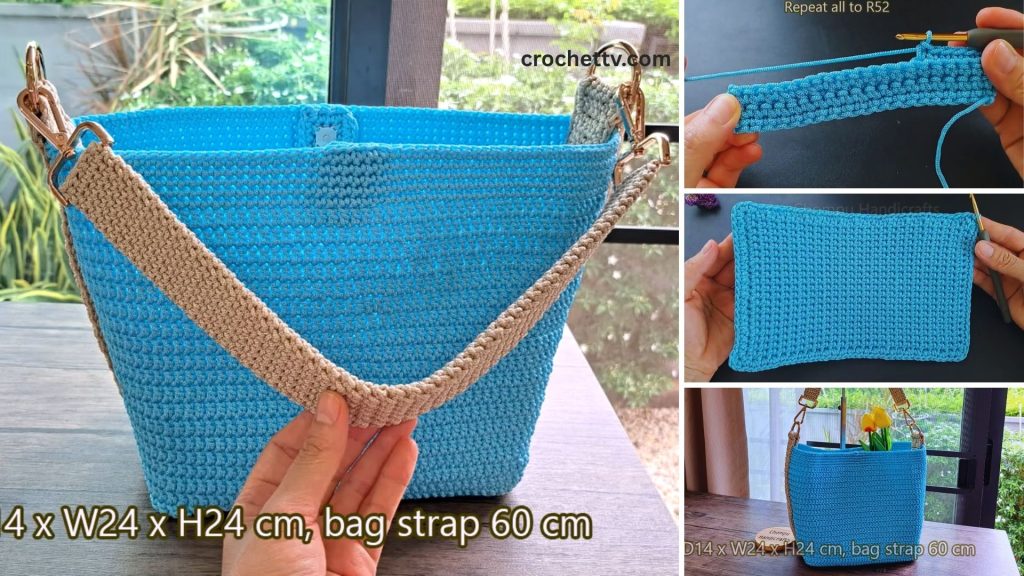
Part 3: Creating the Handles
The handles will extend directly from the top of your bag, using simple single crochet stitches for a consistent and sturdy finish.
- Round for Handle Placement:
- After your last body round, chain 1 (ch 1 – this does not count as a stitch).
- Work 8 single crochet (sc) stitches. (This section of stitches forms the part of the bag opening before your first handle).
- Chain 30 (ch 30 – this creates the length of your first handle. You can easily adjust this number to make the handle longer or shorter for shoulder or hand carrying).
- Skip the next 12 stitches. (This creates the open space for the bag’s main opening).
- Work 16 sc stitches. (This section bridges the gap between your two handles).
- Chain 30 (ch 30 – this creates the length of your second handle, matching the first).
- Skip the next 12 stitches.
- Work 8 sc stitches. (This should bring you back to the start of the round, creating the other part of the bag opening).
- Slip stitch (sl st) into the first sc of this round to join.
- Round for Handle Strengthening:
- Chain 1.
- Work 1 sc into each of the 8 sc stitches from the previous round.
- Now, you’ll work single crochets around your chain-30 handle loop. Work 30 sc stitches by inserting your hook into the chain itself, forming a solid handle.
- Work 1 sc into each of the 16 sc stitches between the handles.
- Work 30 sc stitches around the second chain-30 handle loop.
- Work 1 sc into each of the remaining 8 sc stitches.
- Slip stitch (sl st) into the first sc of the round to join.
- Fasten Off:
- Cut your yarn, leaving a 6-inch (15 cm) tail.
- Yarn over with your hook, pull the cut tail completely through the loop left on your hook, and gently tug to secure the knot.
Part 4: Final Finishing Touches
- Weave in All Ends:
- This is a crucial step for a neat and professional-looking bag. You’ll have at least two tails: one from your starting chain and one from the final fasten-off at the handle.
- Use your yarn needle to meticulously weave in every loose yarn tail.
- How to Weave Neatly: Thread the yarn tail onto your yarn needle. Weave the tail into the stitches of your bag, going in one direction for at least 1-2 inches (2.5-5 cm). To truly secure it, subtly change direction (e.g., weave along a stitch, then turn and weave back through some of the same stitches diagonally or perpendicularly) to “lock” the tail in place and prevent it from unraveling. Trim any excess yarn close to the fabric, being careful not to cut any of your actual stitches.
- Blocking (Optional):
- Blocking can significantly improve the shape of your bag, even out any tension inconsistencies, and give it a more polished, professional look. It helps the bag stand up nicely.
- Method: Gently mist the bag evenly with cool water using a spray bottle until it’s damp but not soaking wet. Stuff the bag lightly with tissue paper, old t-shirts, or a small towel to help it hold its intended shape (especially the corners and handles). Allow the bag to air dry completely and thoroughly in a well-ventilated area. This might take a day or two.
- Optional: Add a Fabric Lining:
- For extra durability and to prevent small items from slipping through the stitches (especially if your tension is looser), consider adding a fabric lining. This involves basic sewing. Measure the finished dimensions of your crocheted bag. Cut fabric pieces slightly larger, sew them into a matching pouch, and then hand-stitch or machine-stitch it inside your crocheted bag.
Congratulations! You’ve successfully created your very own DIY Crochet Tote Bag! This project is a fantastic accomplishment for any beginner, and you now have a sturdy, handmade bag that’s both functional and stylish.
What will be the first thing you carry in your new handmade tote?

